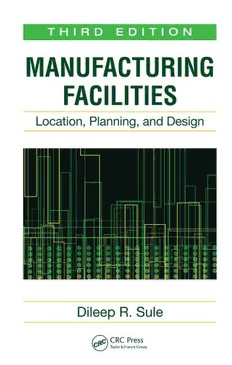
Manufacturing Facilities : Location, Planning, and Design, Third Edition PDF
Preview Manufacturing Facilities : Location, Planning, and Design, Third Edition
T H I R D E D I T I O N MANUFACTURING FACILITIES Location, Planning, and Design 44222_C000.indd 1 11/7/08 9:47:08 AM 44222_C000.indd 2 11/7/08 9:47:08 AM T H I R D E D I T I O N MANUFACTURING FACILITIES Location, Planning, and Design Dileep R. Sule Boca Raton London New York CRC Press is an imprint of the Taylor & Francis Group, an informa business 44222_C000.indd 3 11/7/08 9:47:08 AM CRC Press Taylor & Francis Group 6000 Broken Sound Parkway NW, Suite 300 Boca Raton, FL 33487-2742 © 2008 by Taylor & Francis Group, LLC CRC Press is an imprint of Taylor & Francis Group, an Informa business No claim to original U.S. Government works Version Date: 20131121 International Standard Book Number-13: 978-1-4200-4423-2 (eBook - PDF) This book contains information obtained from authentic and highly regarded sources. Reasonable efforts have been made to publish reliable data and information, but the author and publisher cannot assume responsibility for the validity of all materials or the consequences of their use. The authors and publishers have attempted to trace the copyright holders of all material reproduced in this publication and apologize to copyright holders if permission to publish in this form has not been obtained. If any copyright material has not been acknowledged please write and let us know so we may rectify in any future reprint. Except as permitted under U.S. Copyright Law, no part of this book may be reprinted, reproduced, transmit- ted, or utilized in any form by any electronic, mechanical, or other means, now known or hereafter invented, including photocopying, microfilming, and recording, or in any information storage or retrieval system, without written permission from the publishers. For permission to photocopy or use material electronically from this work, please access www.copyright. com (http://www.copyright.com/) or contact the Copyright Clearance Center, Inc. (CCC), 222 Rosewood Drive, Danvers, MA 01923, 978-750-8400. CCC is a not-for-profit organization that provides licenses and registration for a variety of users. For organizations that have been granted a photocopy license by the CCC, a separate system of payment has been arranged. Trademark Notice: Product or corporate names may be trademarks or registered trademarks, and are used only for identification and explanation without intent to infringe. Visit the Taylor & Francis Web site at http://www.taylorandfrancis.com and the CRC Press Web site at http://www.crcpress.com Contents Preface.....................................................................................................................xxi Chapter 1 Introduction..........................................................................................1 1.1. Nature.and.Scope.of.Part.I.............................................................................1 1.2. Nature.and.Scope.of.Part.II............................................................................3 1.3. The.Role.of.a.Facility.Planner........................................................................5 1.4. Computer.Programs........................................................................................5 Suggested.Readings....................................................................................................6 PART 1 Planning and Design Chapter 2 Product.Development...........................................................................9 2.1. Market.Research.............................................................................................9 2.1.1. Market.Potential.............................................................................10 2.1.2. Collection.of.Data..........................................................................11 2.1.3. Survey.Form...................................................................................11 2.1.4. Basic.Steps.in.Market.Research.....................................................12 2.1.5. Market.Decision.............................................................................13 2.1.6. An.Example.of.Market.Research...................................................13 2.2. Quality.Function.Deployment......................................................................17 2.3. Forecasting...................................................................................................20 2.3.1. Error.Measuring.............................................................................21 2.3.2. Forecasting.Methods......................................................................21 2.3.2.1. Moving.Average...........................................................21 2.3.2.2. Weighted.Moving.Average...........................................22 2.3.2.3. Exponential.Smoothing................................................23 2.3.2.4. Curve.Fitting................................................................25 2.3.3. Demand.Forecasting.for.a.New.Company.....................................28 2.4. Design...........................................................................................................29 2.5 Design.for.Manufacture................................................................................31 2.5.1. Design.Principles.in.DFM.............................................................31 2.5.2. Concurrent.Engineering.................................................................33 2.5.3. Role.of.QFD,.DFM,.and.CE.in.Facility.Planning.........................33 2.6. Drawings.......................................................................................................34 2.6.1. Bill.of.Materials.............................................................................34 2.6.2. Additional.Drawings......................................................................36 2.7. Economic.Evaluation.of.Processes...............................................................37 2.8. Computer-Aided.Design...............................................................................40 2.9. Computer.Program.Description...................................................................43 2.9.1. Summary........................................................................................43 44222_C000.indd 5 11/7/08 9:47:10 AM Problems...................................................................................................................44 Suggested.Readings..................................................................................................48 Chapter 3 Automation.........................................................................................49 3.1. Sensing.Methods..........................................................................................49 3.2. Bar.Codes.....................................................................................................51 3.2.1. Principles.of.Bar.Code.Technology...............................................51 3.2.2. Bar.Code.Symbologies...................................................................51 3.2.2.1. 2.of.5.Code...................................................................55 3.2.2.2. Interleaved.2.of.5.Code................................................56 3.2.2.3. Code.3.of.9...................................................................57 3.2.3. Universal.Product.Code.................................................................58 3.2.4. Applications.of.the.Bar.Code.........................................................61 3.2.5. Equipment.Used.in.Bar.Code.Applications...................................62 3.2.5.1. Bar.Code.Readers.........................................................63 3.2.5.2. Bar.Code.Printers.........................................................65 3.2.5.3. Bar.Code.Verifiers/Analyzers.......................................66 3.3. Radio.Frequency.Identification.System........................................................66 3.3.1. How.Does.The.RFID.System.Work?.............................................67 3.3.2. Radio.Data.Communication...........................................................68 3.4. Machine.Vision............................................................................................68 3.4.1. Applications.of.Machine.Vision....................................................69 3.4.2. Typical.Machine.Vision.Setup.......................................................70 3.4.3. Uses.of.Machine.Vision.in.Manufacturing....................................71 3.4.4. Two-.and.Three-Dimensional.Machine.Vision.............................71 3.4.5. Machine.Vision.Processing............................................................72 3.5. Voice.Input...................................................................................................77 3.6. Programmable.Logic.Controllers.................................................................77 3.6.1. PLC.in.Material.Handling.............................................................82 3.7. Numerically.Controlled.Machines...............................................................86 3.7.1. Components.of.NC.Machines........................................................86 3.7.1.1. Instructions...................................................................86 3.7.1.2. Control.Unit..................................................................87 3.7.1.3. Machine.Tool................................................................88 3.7.2. Machine.System.............................................................................88 3.7.2.1. Conventional.NC.Machine...........................................88 3.7.2.2. Direct.Numerical.Control.............................................89 3.7.2.3. Computer.Numerical.Control.......................................89 3.7.2.4. Modern.DNC................................................................89 3.7.3. Advantages.of.NC.Machines.........................................................90 3.7.4. Classification.of.NC.Machines......................................................90 3.8. Industrial.Robots..........................................................................................93 3.8.1. Degrees.of.Freedom.......................................................................93 3.8.2. Classification.of.Robots.................................................................94 3.8.3. Robot.Programming.......................................................................94 44222_C000.indd 6 11/7/08 9:47:10 AM 3.8.4. Selecting.a.Robot...........................................................................94 3.8.5. Summary........................................................................................95 Problems...................................................................................................................96 Suggested.Readings................................................................................................101 Chapter 4 Production.Charts.and.Systems.......................................................103 4.1. Production.Charts.......................................................................................103 4.1.1. Symbols.and.Descriptions............................................................103 4.1.2. Assembly.and.Operation.Process.Charts.....................................104 4.1.3. Time.Estimates............................................................................106 4.1.4. Routing.Sheet.or.Production.Work.Order....................................107 4.1.5. Other.Charts.................................................................................108 4.1.5.1. Left-Hand,.Right-Hand.Chart....................................108 4.1.5.2. Gang.Chart.................................................................109 4.1.5.3. Gantt.Chart.................................................................110 4.1.5.4. Flow.Process.Chart....................................................111 4.2. Production.Systems....................................................................................111 4.2.1. Job.Shop.Production....................................................................111 4.2.2. Batch.Production..........................................................................113 4.2.3. Mass.Production...........................................................................114 4.2.4. Cellular.and.Flexible.Manufacturing...........................................114 4.3. Cell.Formation.in.Group.Technology........................................................116 4.3.1. Solution.Procedure.......................................................................117 4.3.1.1. Phase.I........................................................................117 4.3.1.2. Phase.II.......................................................................119 4.3.1.3. Phase.III:.Further.Group.Evaluation.with. Additional.Objectives.................................................123 4.3.1.4. Phase.III.Procedure....................................................123 4.3.2. Layout.Considerations.with.Cellular.Manufacturing..................128 4.4. Labor.Assignments.....................................................................................128 4.4.1. Labor.Assignment.in.Production.Lines.......................................129 4.4.1.1. Labor.Planning...........................................................132 4.4.2. Assembly.Line.Balancing............................................................132 4.4.2.1. Balancing.Procedures.................................................133 4.4.3. Parallel.Grouping.of.Stations.......................................................139 4.4.4. Computerized.Assembly.Line.Programs.....................................141 4.4.4.1. Applicable.Programs.by.Others.................................141 4.5. Computer.Program.Description.................................................................141 4.5.1. Assembly.Line.Balancing.(in.GW-BASIC).................................142 4.5.1.1. Largest.Candidate.Rule..............................................142 4.5.1.2. RPW.Method..............................................................142 4.5.2. GT.Computer.Programs...............................................................142 4.5.2.1. Group..........................................................................143 4.5.2.2. Largroup.....................................................................144 4.6. Summary....................................................................................................144 44222_C000.indd 7 11/7/08 9:47:11 AM Problems.................................................................................................................147 Suggested.Readings................................................................................................152 Chapter 5 Requirements.and.Selection.of.Machines.and.Labor......................155 5.1. Machine.Selection......................................................................................155 5.1.1. Make-or-Buy.Analysis.................................................................155 5.1.2. Sources.of.Information................................................................158 5.1.2.1. Books.and.Periodicals................................................158 5.1.2.2. Computer.Databases...................................................159 5.1.3. Production.Arrangement..............................................................160 5.1.4. Cost.Consideration.......................................................................160 5.1.5. Available.Capacity.......................................................................160 5.1.6. Required.Capacity........................................................................162 5.1.7. Number.of.Machines.Needed......................................................162 5.1.7.1. Extensions.of.Variations.on.Stage.Analysis...............164 5.1.7.2. System.Decomposition...............................................166 5.1.8. Machine.Specifications................................................................169 5.1.9. Auxiliary.Equipment...................................................................171 5.2. Labor.Requirement.and.Selection..............................................................171 5.2.1. Job.Evaluation..............................................................................171 5.2.1.1. Sample.Job.Evaluation:.Machine.Shop.Supervisor....173 5.2.1.2. Sample.Job.Evaluation:.Salary.Determination...........173 5.2.2. Standard.Job.Analysis..................................................................174 5.2.3. Job.Definition.and.Description....................................................175 5.3. Machine.Coupling......................................................................................177 5.3.1. Example.of.Machine.Coupling....................................................177 5.3.1.1. Alternative.A..............................................................177 5.3.1.2. Alternative.B..............................................................178 5.3.1.3. Alternative.C..............................................................178 5.3.1.4. Alternative.D..............................................................180 5.4. Total.Personnel.Requirement.....................................................................181 5.5. Summary....................................................................................................183 Problems.................................................................................................................183 Suggested.Readings................................................................................................187 Chapter 6 Lean.Manufacturing.and.Supply.Chain...........................................189 6.1. Lean.Manufacturing...................................................................................189 6.1.1. 5S.System.....................................................................................190 6.1.1.1. Sort.............................................................................190 6.1.1.2. Straighten....................................................................191 6.1.1.3. Shine...........................................................................193 6.1.1.4. Standardize.................................................................193 6.1.1.5. Sustain........................................................................193 6.1.2. Six.Sigma.....................................................................................194 6.1.2.1. Define.........................................................................194 6.1.2.2. Measure......................................................................194 44222_C000.indd 8 11/7/08 9:47:11 AM 6.1.2.3. Analyze.......................................................................195 6.1.2.4. Improve.......................................................................197 6.1.2.5. Control........................................................................197 6.1.2.6. Replicate.....................................................................198 6.1.3. Kaizen.Philosophy.......................................................................198 6.1.4. Andon...........................................................................................199 6.1.5. Takt.Time.....................................................................................200 6.1.6. Single.Minute.Exchange.of.Die...................................................201 6.1.7. Value.Stream.Mapping.................................................................202 6.1.8. Kanban.........................................................................................207 6.1.9. Total.Production.Maintenance.....................................................209 6.1.9.1. Available.Time.on.Machine.......................................209 6.1.9.2. Machine.Speed...........................................................210 6.1.9.3. Increase.Yield.............................................................210 6.1.10. Visual.Management.....................................................................212 6.1.11. Multiskill.Workers.......................................................................213 6.1.12. A.Case.Study.in.Lean..................................................................214 6.1.13. Toyota.Production.System............................................................242 6.2. Supply.Chain..............................................................................................242 6.2.1. Distribution.Problem....................................................................243 6.2.2. Aggregate.Planning.Model..........................................................244 6.2.2.1. Formulation.and.Solution...........................................245 6.2.3. Just-in-Time.Production/Pickups.................................................247 6.2.3.1. Linear.Heuristic.Programming.Formulation.............248 6.3. Summary....................................................................................................251 Problems.................................................................................................................251 Chapter 7 Building,.Organization,.Communications,. and.Selected.Support.Requirements................................................255 7.1. Building......................................................................................................255 7.1.1. Conventional.Building.Characteristics........................................255 7.1.1.1. Structure.....................................................................256 7.1.1.2. Walls...........................................................................256 7.1.1.3. Floor...........................................................................256 7.1.1.4. Roof............................................................................257 7.1.1.5. Interior........................................................................257 7.1.2. Prefabricated.Buildings................................................................258 7.2. Organization...............................................................................................258 7.2.1. Organizational.Concepts..............................................................258 7.2.2. Organization.Charts.....................................................................259 7.2.3. Organizational.Structures............................................................259 7.2.3.1. Line.Organization.......................................................259 7.2.3.2. Staff-Line.Organization.............................................260 7.2.3.3. Product.Organization.................................................261 7.2.3.4. Matrix.Organization...................................................262 7.2.4. Selection.of.Organization.Structure............................................262 44222_C000.indd 9 11/7/08 9:47:12 AM
